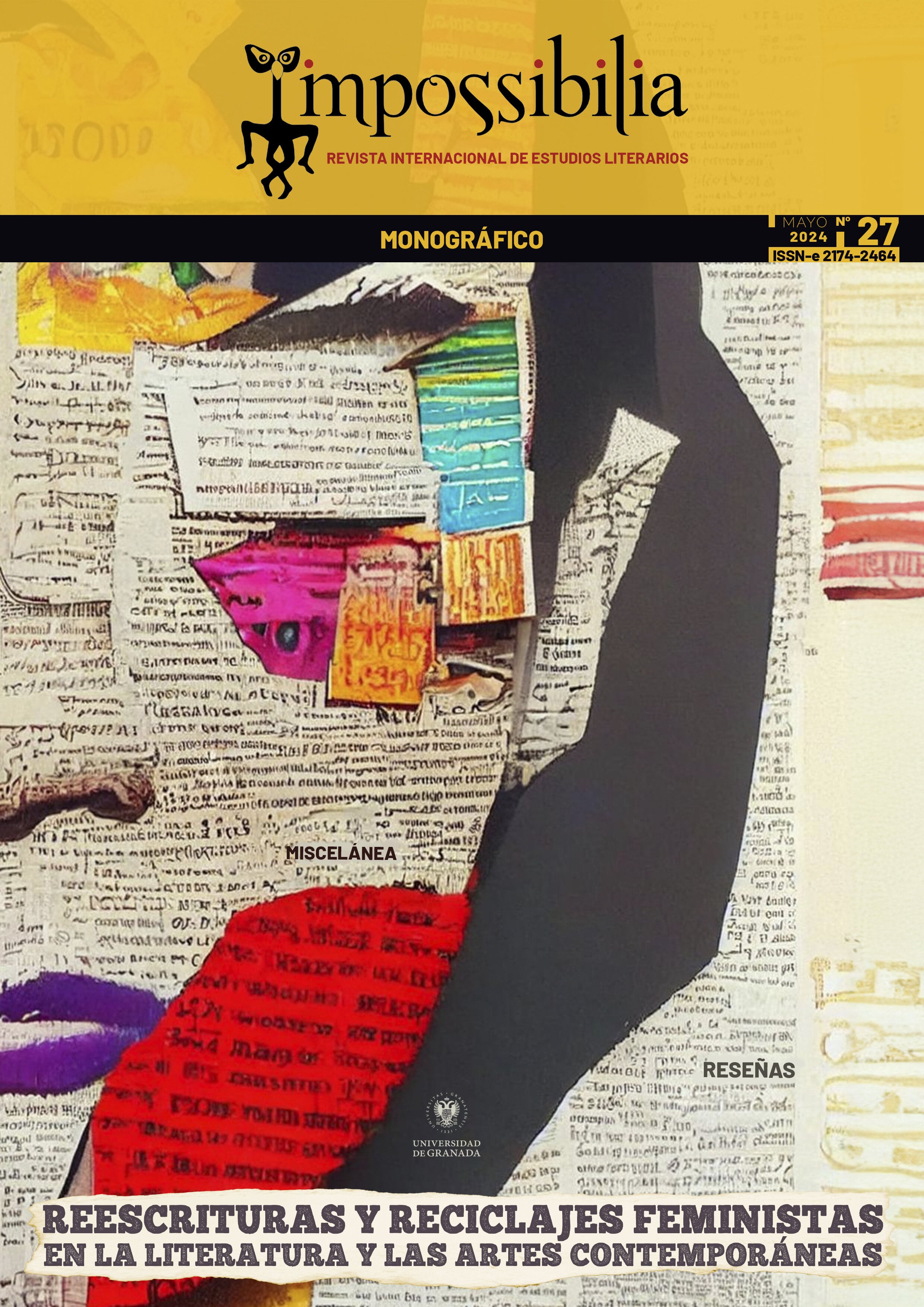Tristana in the Literary Criticism of Elvira Lindo: The Feminist Revision of a Literary Classic
DOI:
https://doi.org/10.30827/impossibilia.272024.28787Keywords:
Feminist Criticism, Images of Women, Elvira Lindo, Benito Pérez Galdós, TristanaAbstract
The aim of this article is to analyze Elvira Lindo’s feminist interpretation of Tristana. We will dwell, therefore, on Lindo’s discourse on Galdós’ narrative construction of female desire. After that, we will study her search for the author’s autobiographical traces in the narrative text, especially the imprint of the woman who inspired Tristana’s psychological portrait, or ethopoeia. After that, we will compare Lindo’s feminist reading with that of Emilia Pardo Bazán and conclude with the author’s reflection on the alleged feminism attributed to Galdós. Ultimately, the aim of this paper is to add to the research on Lindo’s critical production with a sample of her contribution to the analysis of the images of women that inhabit canonical literature.
Downloads
References
ARENCIBIA, Yolanda (2021). Galdós en Pardo Bazán y Concha Morell. La Tribuna. Cadernos de Estudos da Casa-Museo Emilia Pardo Bazán, (16), 21-28.
ARIAS CAREAGA, Raquel (2001). Estudio preliminar. En PÉREZ GALDÓS, Benito. Tristana (Edición de Raquel Arias Careaga) (5-64). Madrid: Ediciones Akal.
ASENSI, Manuel (2011). Crítica y sabotaje. Barcelona: Anthropos.
BALLART, Pere; & JULIÀ, Jordi. (2019). Crítica y pensamiento literario catalán en el siglo XX. En POZUELO YVANCOS, José María; RODRÍGUEZ ALONSO, Mariángeles; BALLART, Pere; JULIÀ, Jordi; OLAZIREGUI, Mari Jose; OTEGI, Lourdes; & RÁBADE VILLAR, María do Cebreiro, Pensamiento y crítica literaria en el siglo XX (203-416). Madrid: Cátedra.
BOOTH, Wayne (1961). La retórica de la ficción. Barcelona: Bosch.
BRAVO VEGA, Julián (2009-2010). Un folletín desconocido de Manuel Ibo Alfaro: La virgen de la pradera. Cuadernos de investigación filológica, (35-36), 197-222.
BUTLER, Judith (2001). El género en disputa. Barcelona: Paidós.
CULLER, Jonathan (1984). Sobre la deconstrucción. Madrid: Cátedra.
DÍEZ DE REVENGA, Francisco (2012). La novela política: novelistas españolas del siglo XXI y compromiso histórico. Valladolid: Servicio de Publicaciones de la Universidad de Valladolid.
GENETTE, Gérard (1991). Figuras III. Barcelona: Lumen.
JIMÉNEZ GÓMEZ, Cristina (2017). La construcción de los personajes femeninos galdosianos desde una instancia receptora de mujer. [Tesis doctoral]. Córdoba: Universidad de Córdoba.
JIMÉNEZ GONZÁLEZ, Cristina (2019). Construcción de los personajes femeninos galdosianos desde una perspectiva de mujer. Vigo: Editorial Academia del Hispanismo.
LINDO, Elvira (2002). Algo más inesperado que la muerte. Barcelona: Seix Barral.
LINDO, Elvira (2005). Una palabra tuya. Barcelona: Seix Barral.
LINDO, Elvira (2010). Lo que me queda por vivir. Barcelona: Seix Barral.
LINDO, Elvira (2018). 30 maneras de quitarse el sombrero. Barcelona: Seix Barral.
LÓPEZ CABRERA, María del Mar (2021). La huella de Galdós en la novela social española contemporánea. Nómadas. Critical Journal of Social and Juridical Sciences, (61), 57-80.
LUNA, Lola (1996). Leyendo como una mujer la imagen de la Mujer. Barcelona: Anthropos.
MANCEBO ROCA, Juan Agustín (2021). La reinterpretación del texto en la pantalla: Nazarín de Benito Pérez Galdós en el imaginario de Luis Buñuel. Cuadernos para la investigación de la literatura hispánica, (47), 147-173.
MILLET, Kate (1970). Política sexual. Madrid: Cátedra.
MOI, Toril (1999). Teoría literaria feminista. Madrid: Cátedra.
NAVAS OCAÑA, Isabel (1997). La narrativa femenina en la crítica periodística: el ABC Cultural. Antagonía, (2), 127-142
NAVAS OCAÑA, Isabel (2008). La Regenta y los feminismos. Estudios filológicos, (43), 141-154.
NAVAS OCAÑA, Isabel (2009). La literatura española y la crítica feminista. Madrid: Fundamentos.
ORTIZ ARMENGOL, Pedro (2000). Vida de Galdós. Barcelona: Booket.
PARDO BAZÁN, Emilia (1892). Realidad, drama de don Benito Pérez Galdós. En PARDO BAZÁN, Emilia. Nuevo Teatro Crítico, 16 (19-69). Madrid: Administración.
PARDO BAZÁN, Emilia (1999). Tristana. En GÓMEZ-FERRER, Guadalupe. La mujer española y otros escritos (178-183). Madrid: Cátedra.
PÉREZ GALDÓS, Benito (1889 [2004]). Realidad. Argentina: El Cid Editor.
PÉREZ GALDÓS, Benito (1892 [2008]). Tristana. Madrid: Cátedra.
POZUELO YVANCOS, José María (1989). Teoría del lenguaje literario. Madrid: Cátedra.
POZUELO YVANCOS, José́ María (2002). Algo más inesperado que la muerte, Elvira Lindo. ABC Cultural, 21/09/2002, 11.
RODRÍGUEZ SÁNCHEZ, María de los Ángeles (2012). Selección de cartas cruzadas entre Concepción Morell y Benito Pérez Galdós durante 1892. Anales galdosianos, XLVII, 81-97.
ROMEO, Félix (2002). Quería escribir una novela con libertad. ABC Cultural, 21/09/2002, 10-11.
SANZ VILLANUEVA, Santos (2002). Algo más inesperado que la muerte, Elvira Lindo. El cultural, 26/09/2002. Disponible en: https://elcultural.com/Algo-mas-inesperado-que-la-muerte.
SHOWALTER, Elaine (1977). A Literature of their Own. British Women Novelist from Brontë to Lessing. New Jersey: Princeton University Press.
TANNER, Tony (1979). Adultery in the Novel: Contract and Transgression. Baltimore: The John Hopkins University Press.
VALLES CALATRAVA, José R. (2002). Diccionario de Teoría de la Narrativa. Granada: Alhulia.
Published
How to Cite
Issue
Section
License
Copyright (c) 2024 Impossibilia. Revista Internacional de Estudios Literarios

This work is licensed under a Creative Commons Attribution-NonCommercial-NoDerivatives 4.0 International License.
















